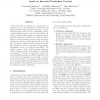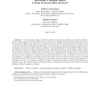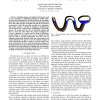245 search results - page 39 / 49 » Motion Planning in Urban Environments |
ICRA
2002
IEEE
14 years 19 days ago
2002
IEEE
Humanoid robot is expected as a rational form of machine to act in the real human environment and support people through interaction with them. Current humanoid robots, however, l...
AR
2004
13 years 7 months ago
2004
-- An inevitable collision state for a robotic system can be defined as a state for which, no matter what the future trajectory followed by the system is, a collision with an obsta...
CA
1999
IEEE
14 years 1 days ago
1999
IEEE
This paper presents a simple and efficient method of modeling synthetic vision, memory, and learning for autonomous animated characters in real-time virtual environments. The mode...
IROS
2009
IEEE
14 years 2 months ago
2009
IEEE
— Mobile robots have to detect and handle a variety of potential hazards to navigate autonomously. We present a real-time stereo vision based mapping algorithm for identifying an...
ICRA
2009
IEEE
13 years 5 months ago
2009
IEEE
Mapping opaque and confined environments such as caves and pipes is a challenging problem for mobile robots because sensor information is severely limited to the immediate proximit...



